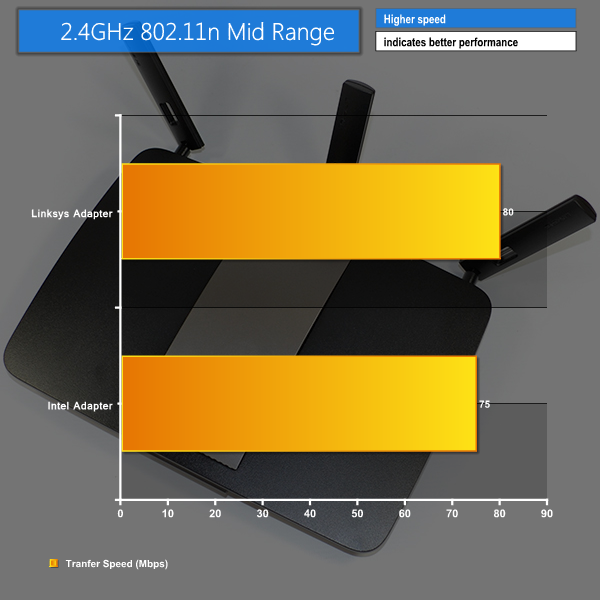Short range:
During short range Wireless-N testing, we observed between one and four competing wireless signals on the 2.4GHz frequency band.
Short range wireless-n performance is nothing out-of-the-ordinary for Linksys' EA6900 router. A maximum transfer speed of just under 120Mbps is actually around 20Mbps slower than the levels achieved by a Tenda N60 wireless router, which was re-tested for comparison purposes.
For my test environment, 2.4GHz performance at short range is stronger than many users living in an urban area may experience. It is almost unheard of for users living in a street of houses to experience only one wireless signal competing for the 2.4GHz frequency band.
Medium range:
During mid range Wireless-N testing, we observed between one and three competing wireless signals on the 2.4GHz frequency band.
Moving through the 20-foot (6 metre) distance and a number of stationary obstacles, transfer speeds offered by the 2.4GHz 802.11n connections are pleasing. The Linksys WUSB6300 adapter is still able to reach 80Mbps, which is perfectly adequate for streaming HD videos and for making smaller file transfers.
While 80Mbps at a distance of 20 feet (6 metres) may seem like a low score for a three-stream router, as previously mentioned, the environment in which testing takes places is particularly challenging in regards to competing WiFi connections and signal-degrading building materials.
Long range:
During long range Wireless-N testing, we observed between four and five competing wireless signals on the 2.4GHz frequency band.
In our analysis environment, the long range testing procedure is highly demanding, there's no question about it. There can be up to sixteen competing wireless connections, interference from home and kitchen appliances, and signal degradation caused by building materials. So why include the results? Because they practically represent a worst-case-scenario environment that those living in a flat or multi-dwelling environment can empathise with.
The 2.4GHz wireless-n connections manage to maintain respectable transfer rates in the long-range test position. Helped by its longer wavelength (in comparison to the 5GHz band), the 2.4GHz signal is efficient in overcoming the degradation effects caused by building materials. Transfer rates of 45-60Mbps were adequate for streaming HD movies, 1080P videos from YouTube, and smaller files.
Despite a challenging test environment that is riddled with interference at longer ranges, wireless-N performance for the Linksys EA6900 is solid. It is likely that signal interference is causing the EA6900 to shy away from the 40MHz channel that would allow TurboQAM to provide a wireless connection of up to 600Mbps 802.11n.
 KitGuru KitGuru.net – Tech News | Hardware News | Hardware Reviews | IOS | Mobile | Gaming | Graphics Cards
KitGuru KitGuru.net – Tech News | Hardware News | Hardware Reviews | IOS | Mobile | Gaming | Graphics Cards






One comment
Pingback: Linksys EA6900 AC1900 802.11ac Wireless Router Review | Dedicated IPs